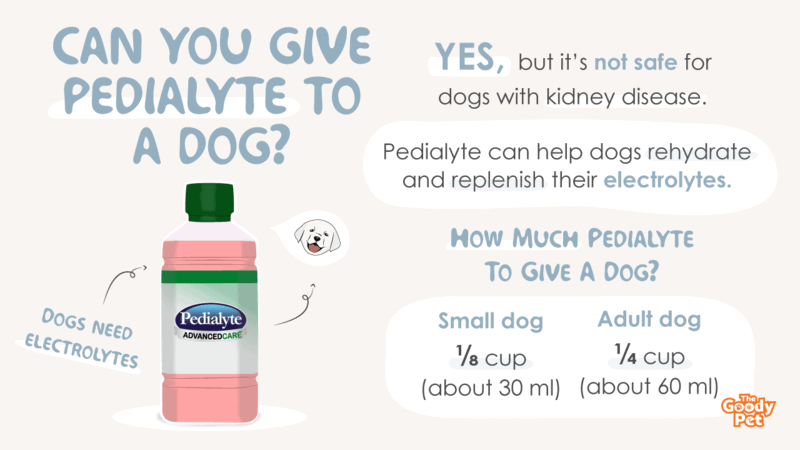If your dog is suffering from dehydration, you may be wondering if it’s safe to give them Pedialyte.
Pedialyte is a sports drink that is designed to replenish electrolytes and fluids in the body. It’s often given to humans when they are dehydrated, and some pet owners have started giving it to their dogs as well.
Most veterinarians agree that you can give Pedialyte to a dog. It is safe for dogs, and it can help them rehydrate and replenish their electrolytes. However, it’s important to give Pedialyte to your dog in moderation. Too much Pedialyte can cause diarrhea and vomiting in dogs.
We will go into more in detail about when it is appropriate to give Pedialyte to a dog, and how much you should administer. We will also share some tips on preventing dehydration in dogs.
Can You Give A Dog Pedialyte?
Before we look at how much Pedialyte you can give a dog, let’s investigate why dogs become dehydrated.
When your fido loses more fluids than it takes in, its body becomes dehydrated. This loss can be due to several factors including vomiting, diarrhea, increased urination, and lack of enough water to drink.
One of the main effects of dehydration is electrolyte imbalance. Also caused by overhydration, the imbalance is a result of low or high levels of minerals such as sodium, calcium, and chloride in the body.
The bottom line is that dogs need electrolytes and if they suffer from low levels, taking an electrolyte-rich fluid helps to drive the levels back up.
What is Pedialyte? A Pedialyte is a rehydration drink rich in electrolytes and nutrients.
As we had noted earlier, the solution is meant for humans, both adults, and kids. Its formulation is, however, also perfect for dogs suffering from dehydration. However, while you can take up to 0.5 gal per day, the dosage for dogs is different.
So, how much Pedialyte to give a dog? Give a small dog ⅛ cup (about 30 ml) of Pedialyte and ¼ cup (about 60 ml) to an adult dog every hour.
Continue giving your furry friend Pedialyte once every hour until dehydration symptoms cease.
Caution: If given in excess, Pedialyte can overwork your dog’s kidneys due to electrolyte imbalances. To ensure that you are not overdosing on your dog, do not give more than 4ml of Pedialyte per 1 pound of weight.
Is Pedialyte Better Than Water?
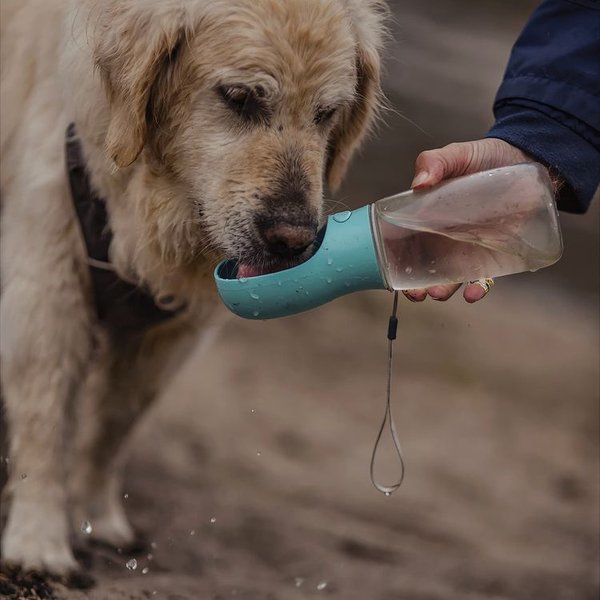
To prevent dehydration, ensure that your four-legged friend has access to water throughout the day. This is especially important during hot days and when your pet is exercising or playing a lot.
Other than water though, there are other alternatives that you can give your dog to drink. Such drinks include:
- Alcohol-free beer and wine
- Milk
- Health tonics
- Caffeine-free herbal tea
However, these alternatives are treats and should not make up your dog’s regular diet.
Similarly, Pedialyte should only be given in cases of mild and severe dehydration, and only when veterinary care is not available.
The reason is that, if given in excess or high concentrations, it can be harmful to your fido’s health. With that in mind, here are some of the side effects of Pedialyte on dogs:
- Worsen disease prognosis
- Cause electrolyte imbalance
- Harm diabetic dogs
- Lead to stomach pains
- Induce vomiting
One of the major worries is the effects of Pedialyte on your canine’s kidneys.
As with humans, one of the main functions of kidneys in dogs is to filter minerals and toxic substances from the body. Since Pedialyte is essentially made of minerals, an important question arises:
Is Pedialyte safe for dogs with kidney disease?
The answer is no.
Pedialyte is not safe for dogs with kidney disease.
Kidney disease makes your dog sensitive to sodium. A build-up of sodium, a main ingredient of Pedialyte, in the body increases blood pressure, causing more damage to already impaired kidneys.
As such, kidney function is reduced resulting in more waste and fluid buildup, making your dog sicker.
What Are The Symptoms Of Dehydration In Dogs?
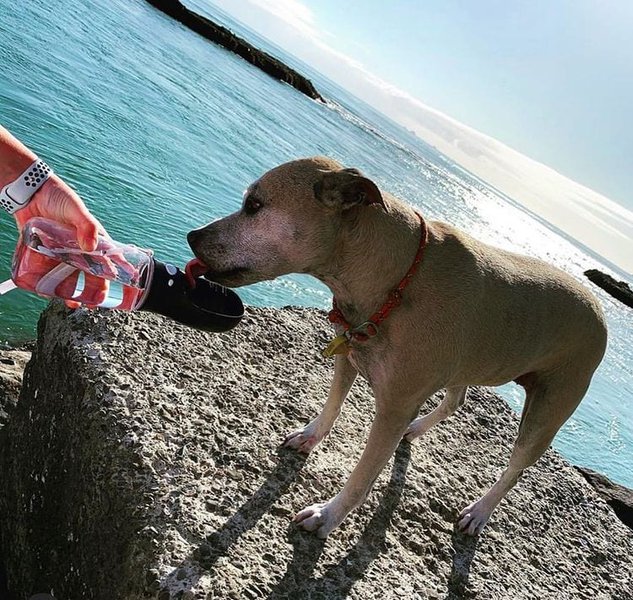
Before you give a dog an electrolyte boost, you must know what the symptoms of dehydration are.
For starters, dehydration causes an imbalance of minerals that are responsible for several functions in your fido’s system. Such functions include a balance of pH, movement of nutrients, facilitation of muscle function, and regulation of nerve functions.
Unfortunately, these are internal roles whose failure can signify a host of other canine diseases.
So, what are the symptoms of low electrolytes?
Lethargy
A lethargic dog will appear tired and sluggish.
They will be uninterested in playing or taking a walk. Lethargy also makes them eat slower and less likely to even respond when called out.
Disorientation, loss of appetite, and restlessness are the other signs of lethargy.
Vomiting And Diarrhea
Though not a must, when your canine is vomiting, chances are that they will also have diarrhea.
This leads to direct loss of fluids.
When both symptoms manifest at the same time and for long, your fido will definitely suffer from severe dehydration,
Dry And Sticky Gums
If a dog’s saliva appears thicker than normal, then they are suffering from dehydration. The same goes for pale, dry, and sticky gums that are normally supposed to be pink, slippery, and wet.
Loss Of Skin Elasticity
This is one of the earliest symptoms of mild to severe dehydration. Loss of skin elasticity is also easy to test by just raising your dog’s skin near the shoulder blades. When you release the skin, if your fido is well hydrated, the skin springs back instantly. If dehydrated, the skin will take a longer time to return to its original position.
How Else Can I Rehydrate My Dog?
The best way to keep your fido from getting dehydrated is by providing him with clean water at all times.
When they get dehydrated though, their bodies lose vital minerals that can’t be replaced by taking water.
Dehydration also comes with a loss of vitality, making it less likely that your dog will drink lots of water. This calls for small amounts of electrolyte-rich fluids.
So, what else can you give a dog for rehydration?
While your furry bundle can lick some milk or juice, these fluids don’t contain the right formulation to fight dehydration. This is where energy drinks such as Pedialyte come highly recommended.
Another good alternative is Gatorade, a sport-themed drink.
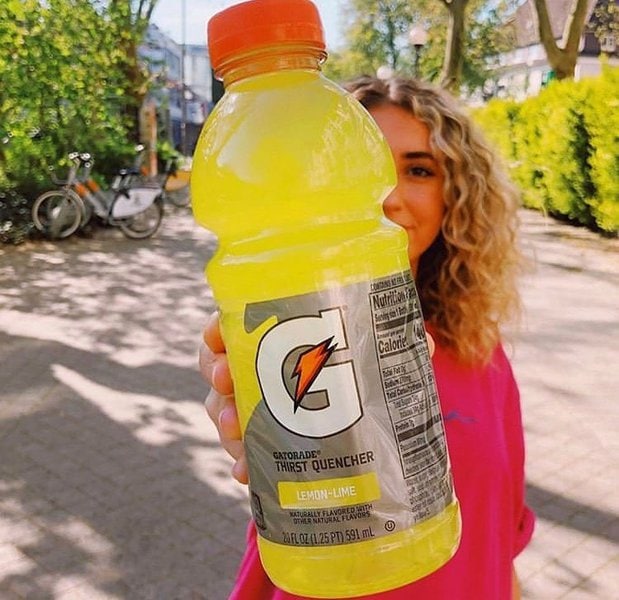
You can give your dog Gatorade in small amounts to get them rehydrated.
However, before you introduce your fido to the drink, consult a vet.
Not only does the beverage contain high levels of sugars but it also comes with food dyes. These ingredients can induce weight gain and diabetes.
As with all sports drinks, you should dilute and introduce Gatorade slowly. This helps to reduce the sodium and sugar concentration in the drink.
As a rule of thumb, mix equal amounts of Gatorade with water. And just like Pedialyte, give your dog the mixture hourly until you get to the vet.
How Do Pedialyte and Gatorade compare? Gatorade has fewer electrolytes and more sugar compared to Pedialyte. As such, for a dehydrated dog, Pedialyte is better at rehydrating and relieving the effects of dehydration and diarrhea.
Homemade Pedialyte For Dogs
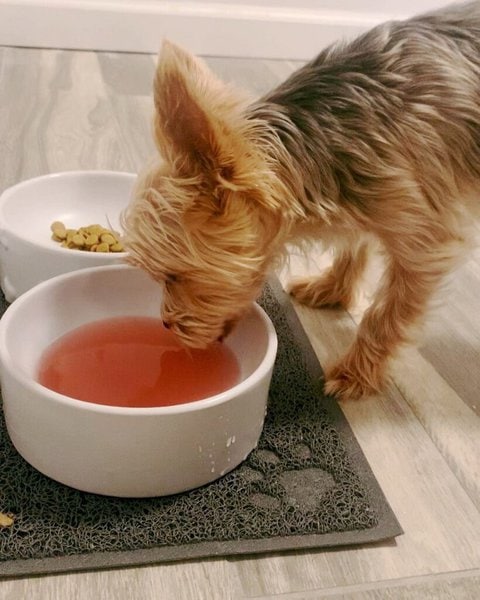
As much as commercial electrolyte-infused drinks are good at rehydrating dogs, they aren’t very practical as humans.
Also, it’s not guaranteed that one will be at hand when your dog needs it.
To this end, it helps to have a DIY solution at hand.
For example, you can make homemade Pedialyte for dogs using everyday ingredients.
The goal is to combine sugars and salts to achieve a concentration of electrolytes necessary for rehydration. The main minerals in the solution are potassium, phosphorus, sodium, chloride, bicarbonate, and sodium.
Ingredients
- Coconut Water: Instead of using natural water as a solvent, go for coconut water. It contains more electrolytes, with a cup providing about 58 mg of calcium, 600 mg of potassium, and 252 mg of sodium.
- Fruit Juice: Fresh fruit juice such as cranberry juice contains rehydrating minerals including chloride and calcium.
- Natural Sugar: You can use either honey, table sugar, fructose, or agape syrup for sugar.
- Salt: Table salt is a good source of sodium and chloride. For an even richer electrolyte solution, you can use sea salt.
Procedure
- Warm the juice (do not allow it to boil).
- Stir in sugar and salt until they dissolve completely.
- Let it cool, add coconut water, and serve.
Alternatively, mix all the ingredients, stir thoroughly, then serve. Freeze into cubes or refrigerate for up to 3 days.
Warning
- Artificial sweeteners, such as aspartame, stevia, or sucralose, do not have a sufficient amount of canine electrolytes.
- Pedialyte made for humans may contain xylitol, a sweetener that is so toxic to dogs that it can cause seizures, liver failure, and even death.
Related Questions
Are Ice Cubes Bad For Dogs?
Ice cubes are not bad for dogs; they are one way of ensuring that your canine buddy gets hydrated. However, chewing on bigger and harder ice cubes can damage your dog’s teeth or lead to choking if not properly chewed. To avoid this, give smaller ice cubes or ice shavings.
How Do Vets Rehydrate Dogs?
Vets rehydrate dogs by giving subcutaneous or intravenous fluids. Intravenous hydration involves placing the dog on a drip to replace lost fluids and prevent further dehydration. It is the most effective method and is great for severe cases. Subcutaneous rehydration works with mild cases. The vet administers fluid under the skin where the body absorbs it gradually.
Do Dogs Need Water At Night?
As long as they have access to clean fresh water during the day, dogs don’t need water at night. In instances when your four-legged companion is suffering from diseases such as diabetes, Cushing’s disease, Addison’s disease, diabetes, or any disease that causes excessive thirst, a little water at night is recommended.

